Read Reviews
The Best Cordless Chainsaws
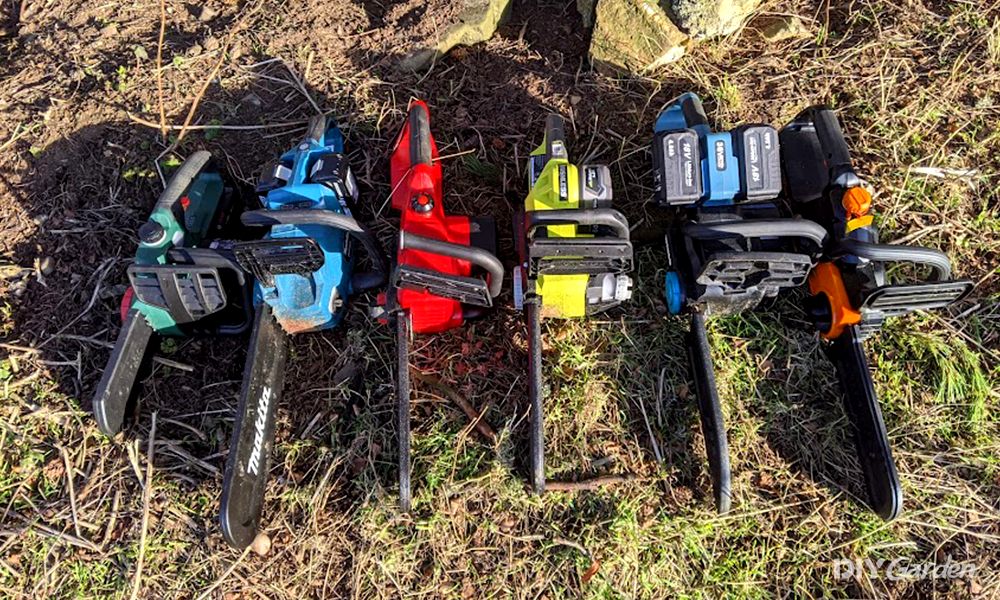
Tackling thick branches or fallen trees calls for specialist equipment. Thankfully nowadays, some cordless chainsaws rival even the top petrol models. We’ve tested the most popular options to see which ones cut it. Excuse the pun. We believe the UK’s best cordless chainsaw is the Makita DUC353Z Twin 18V Cordless Chainsaw. This is because of its powerful motor, fast cutting speed, and top safety features.
-
Best overall - Ryobi RCS1830-150 18V ONE+ Cordless Brushless Chainsaw
-
Best professional model - Makita DUC353Z Twin Li-Ion LXT Cordless Chainsaw
-
Best budget chainsaw - WORX WG322E.9 18V Cordless Compact Chainsaw
-
Best for beginners - Bosch Cordless Chainsaw UniversalChain 18
-
Best for tree pruning and firewood - Einhell GE-LC 18/25 Li Power X-Change Cordless Chainsaw
-
Best for no assembly - WESCO 36V Cordless Chainsaw
Cordless Chainsaw Reviews
- Fast assembly takes just 10 minutes and doesn’t require any tools
- Has a 30cm Oregon bar and chain, which means quality and versatility
- Offers a fast cutting speed of 10 m/s
- Capable of cutting through wood with a maximum diameter of 50cm when you cut from both sides
- Very lightweight at just 3.5kg with the battery in, making it so easy to manoeuvre and use in awkward angles
- Has a powerful brushless motor that very rarely stalls
- The batteries charge quickly - a 5.0aH battery will go from 0-100% in just an hour
- Relatively short battery life of 20-25 minutes when used on thick wood with a 5.0aH battery (runtime will increase if you use it on smaller pieces of wood)
- Voltage
- 18V
- Battery
- 1 x 5.0Ah
- Bar Size
- 30cm
- Weight
- 2.5kg
- Assembly Ease
- 5
- Design
- 5
- Performance
- 5
- Power
- 5
- Ease of Use
- 5
- Safety
- 4
- Value for Money
- 4.5
Ryobi’s power tools are usually very capable and reliable (I recently reviewed the brand’s cordless strimmer and leaf blower and thought exactly that), so I was excited to be testing out their ONE+ Cordless Brushless 30cm Chainsaw. Storm Arwen had toppled several large trees around my farm, so not only did I have their big trunks to slice up into logs, but I also had a huge blanket of branches that needed to be cut up for firewood. Incidentally, Ryobi states that this battery powered chainsaw has been designed for cutting logs and firewood, so this was the perfect chance to put this machine through its paces.
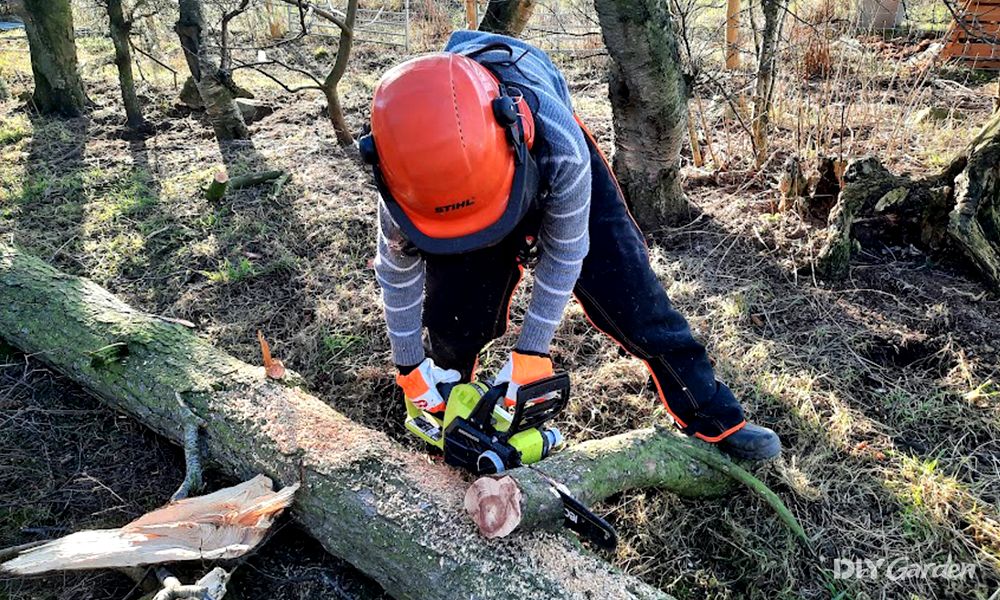
The first thing that stood out to me about this 18V chainsaw was its 30cm Oregon bar and chain – a sign of top quality. It has also been designed with a brushless motor, which makes any machine significantly more efficient. Other than that, the rest of its design features were pretty standard, but there were definitely no flaws either.
In terms of performance, this machine is definitely impressive. If you cut from both sides, it’ll slice through wood with a maximum diameter of around 50cm, making it incredibly versatile. It works pretty quickly too – its cutting speed of 10 m/s is much faster than most of the other chainsaws that I tested, and it also felt noticeably more powerful.
That said, a fast cutting speed is a must when you only have a runtime of about 20 minutes with a 5.0aH battery. Granted, I was cutting through very thick and dense wood (it’ll last for longer if you’re using it for lighter material), but even Ryobi states that you can only expect about 40 cuts with each charge. It took about an hour to charge the battery each time. So, if you wanted to cut wood for a few hours, which this motor is more than capable of doing, you would need to have at least three batteries that you could keep swapping around.
Although the runtime was a little disappointing, the chainsaw makes this worth dealing with when you take into account how easy it is to use. Even with the battery in, it weighs just 3.5kg, making it so lightweight and comfortable to work with. Its metal gripper spikes help to hold the machine steady while you’re cutting, and its automatic oiling system works well.
When it comes to safety, this chainsaw offers the standard features, with the most important being its chain brake that’ll stop the chain from hitting you if it ever derails or breaks. At 94 dB(A), it’s a pretty quiet machine too – more so than the other chainsaws that I tested.
But how does this machine compare to the others when it comes to price? The Ryobi sits somewhere in the middle. Yes, you could buy yourself a more powerful petrol chainsaw for less, but you’d end up with a much heavier and more cumbersome machine. Plus, with its powerful motor and fast cutting speed, this one will do just about anything that a similar-sized petrol chainsaw will do – it really does function so well.
Would I recommend this machine to others? Yes, without a doubt. It did so much better than I expected it to, and it’s one that can be used for such a wide range of tasks. Whether you’re cutting small batches of firewood or felling a medium-sized tree, this is a machine that you’ll be able to rely on, making it a very worthwhile investment. It’s also a great option if you’re after something lightweight; at 3.5 kg it’s very easy to work with.
Did you find this review helpful?
2. Makita DUC353Z Twin Li-Ion LXT Cordless Chainsaw
Best professional model
- Uses two 18V batteries, which gives it double the power of chainsaws that only use one
- Two 5aH batteries give you a continuous run time of 30 minutes at top speed
- You can choose from variable speeds when pulling the trigger, which gives the machine more versatility
- Has a fast maximum cutting speed of 20 m/s, which saves a lot of time when you’ve got a large amount of wood to cut
- Its 35cm bar is ideal for a wide variety of tasks (it slices through wood with a maximum diameter of around 65cm)
- Easy, tool-less assembly takes less than 10 minutes
- Comes with an Oregon chain, which is known for being top-quality
- The powerful motor has the potential to run a slightly larger bar and chain if needed
- Has a metal spike bumper that gives you more control when cutting
- Fitted with a number of important safety features
- Is more of an initial investment than many other chainsaws (however, in my opinion, it’s worth it, as this one will last you for years)
- Voltage
- Twin 18V (36V)
- Battery
- Not Included
- Bar Size
- 35cm
- Weight
- 4.04kg
- Assembly Ease
- 5
- Design
- 5
- Performance
- 5
- Power
- 5
- Ease of Use
- 5
- Safety
- 5
- Value for Money
- 5
Makita is famed for being one of the best power tool brands around and, after testing many of their cordless tools, I can see why. So, while I had high hopes for their DUC353Z Twin 18V Cordless Chainsaw, I was also a little doubtful about whether or not it would be up to the task that I had in mind for it – helping me to slice up the several mature trees that Storm Arwen had scattered around my farm.
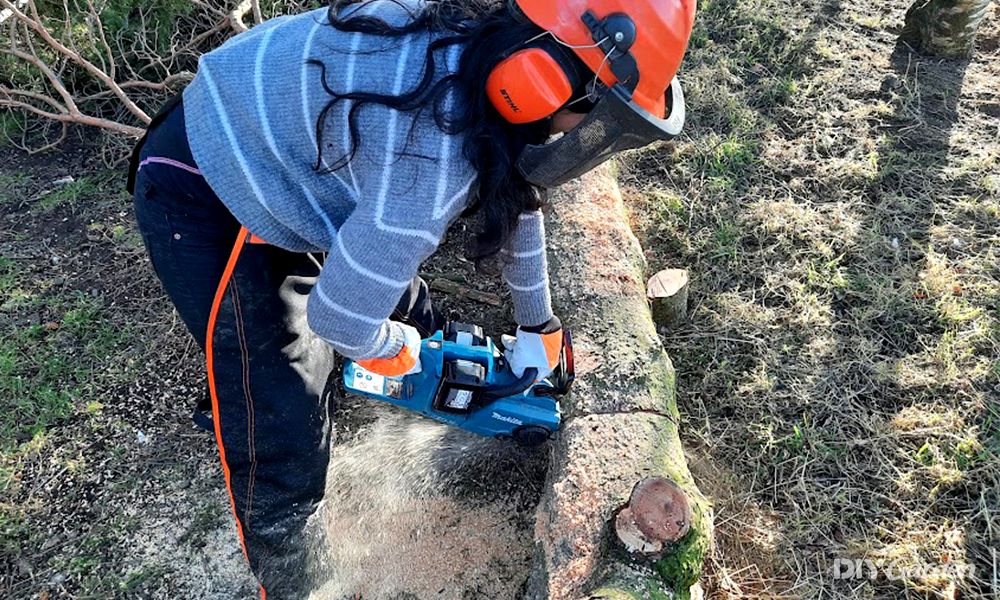
In terms of appearances, this is clearly a Makita tool – I love the blue and black colour palette that the brand uses for all of their products. When it comes to design features, this battery powered chainsaw is definitely impressive. It holds two batteries, has a sturdy 35cm bar with an Oregon chain (you don’t get better quality chains), along with an on/off button, ergonomic handles, and a metal spike bumper, which should give the chainsaw better leverage.
I was already impressed after examining this machine’s design, but became even more so once I started to actually use the chainsaw. It performed brilliantly – I can’t fault it at all. From small branches to tree trunks with a diameter of around 65cm, this chainsaw sliced through it all without once stalling or requiring any force. I even had a professional tree surgeon test out the six chainsaws that I was reviewing, and, having always had a low opinion of battery powered chainsaws, he was even more impressed than I was at how it performed, to the point where he now wants to buy his own Makita!
This chainsaw’s fantastic performance is partly due to how powerful it is. As mentioned, its 36V motor makes use of two 18V batteries, giving it double the power of its 18V competitors. I went with 5aH batteries and enjoyed a continuous run time of about 30 minutes. I was using it at full speed for pretty much all of this time, meaning 20 m/s, which, again, is significantly faster than many of the other battery powered chainsaws out there. If you use the machine at a slower speed and on smaller pieces of wood, you’ll enjoy a longer runtime.
In addition to its performance and power, this chainsaw really excels when it comes to how easy it is to use. I don’t have a huge amount of chainsaw experience but I felt confident when using this machine. It’s lightweight enough (5kg) to manoeuvre into awkward angles, yet has enough weight behind it to remain sturdy. Its automatic chain lubrication feature is another plus.
Good safety is a must when it comes to chainsaws, which is why you’ll find several safety features incorporated into this one. From its chain brake to its kickback brake to the way in which it automatically turns off if the machine is set down, Makita has done all that it can to keep whoever uses this chainsaw as safe as possible. That said, make sure that you’re still wearing all of the necessary safety gear when using any chainsaw!
Now for the only downside to this chainsaw – its price. It was the most expensive battery powered chainsaw that I tested, and it was even more expensive than all of the petrol chainsaws that I also tested, and that’s not accounting for the batteries and the dual charger. That said, it’s still a machine that I would highly recommend buying, simply because of how durable it feels and how well it performs. The fact that its performance is equivalent to that of many petrol chainsaws, yet it’s so much easier to use, makes it, in my opinion, well worth the higher cost.
I’ll be honest – I didn’t expect any of the best battery powered chainsaws that I was testing to be able to match a petrol chainsaw in terms of performance, but this Makita chainsaw did. Not only that, but it’s so much easier to use. The only thing that it would struggle to do would be heavy-duty tree felling, but, other than that, it’s a machine that I would recommend to just about everyone – both home users and professionals will quickly come to rely on this chainsaw, just as I have.
Did you find this review helpful?
3. WORX WG322E.9 18V Cordless Compact Chainsaw
Best budget chainsaw
- Assembly is quick and pain-free - it only takes 5 minutes and no tools are needed
- At just 3kg, this is a very lightweight, and therefore easy to use, machine. It’s also extremely compact in size
- Has a 25cm bar that can tackle wood with a maximum diameter of around 35cm (if you do a cut on either side)
- Can take either an 18V or a 20V battery, which makes life easier if you already own a WORX Powershare battery
- A major lack of safety features makes this chainsaw unsuitable for beginners, even though this is the market that WORX is trying to target with this machine
- Has a relatively slow cutting speed of 3.7 m/s
- Bumper spikes are made from plastic rather than metal. Although they still work well, they’re not quite as effective as metal spikes
- Voltage
- 20V
- Battery
- 1 x 2Ah
- Bar Size
- 25cm
- Weight
- 3.1kg
- Assembly Ease
- 5
- Design
- 4
- Performance
- 4
- Power
- 4
- Ease of Use
- 5
- Safety
- 3.5
- Value for Money
- 3.5
Thanks to Storm Arwen, I had several mature trees uprooted around my farm, along with a blanket of branches and other debris that needed to be tidied up. While I was counting on a petrol chainsaw to help me with the largest of the trunks, I was hoping to find a smaller and lighter machine to tackle the other branches since I didn’t fancy dealing with the weight of a petrol chainsaw for several hours straight. So, I turned to the WORX Cordless Compact Chainsaw. Having already tested, reviewed, and fallen in love with their cordless strimmer, I was expecting their battery powered chainsaw to be just as impressive.
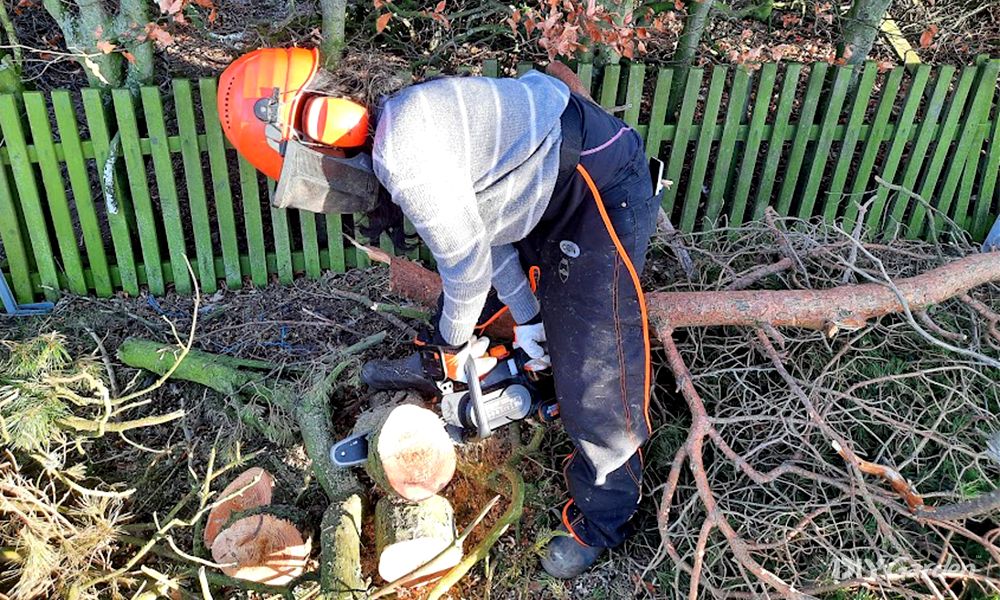
Once assembled, it was clear to see that this chainsaw really lives up to its name in terms of being compact. Although it does have a sturdy 25cm bar, the unit itself looks smaller and feels less bulky than many of the other cordless chainsaws out there. On the downside, it seems a little flimsier too – even the bumper spikes at the front of the machine are made from plastic, rather than metal, which does give the chainsaw a slightly cheaper finish. However, there are some thoughtful design touches here as well, from the oil level window to the way in which the battery is positioned underneath the rear handle to save it from bumps and scratches.
In terms of performance, this chainsaw did pretty well. The maximum diameter of wood that it can cope with is around 35cm (when you cut from both sides), but the smaller you go, the better the chainsaw performs.
I was a little disappointed with the chain speed of this saw. At just 3.7 m/s, it’s slower than all of the other chainsaws that I tested, which is strange considering that WORX has designed this machine to take either a 20V or 18V battery. I went with a 20V 5aH lithium ion battery, which gave me about an hour of continuous cutting time. I was hoping to quickly charge up while taking a short break, but charging is slow – it took a few hours to recharge the battery, so it would be worthwhile having a spare compatible battery around if you have a large job in mind.
Where this battery powered chainsaw really shines is in how easy it is to use. I loved how lightweight this machine is – at just 3kg, even with the battery in, it’s not going to leave your arms aching, which cannot be said for most of the other chainsaws that I tested.
Unfortunately, when it comes to safety features, WORX really missed the mark. Unlike the other chainsaws that I reviewed, this one doesn’t have a low kickback mechanism or a chain brake. Granted, it boasts a lock button and a few safety stickers, along with plenty of safety information in the instruction manual, but this isn’t going to help you much if the chain breaks while you’re using the machine.
Considering this big oversight, I would have to say that this chainsaw is a little pricey. You could spend a similar amount of money and bag yourself a chainsaw that’s fitted with all of the right safety features while also having a larger motor and longer bar. However, it wouldn’t be easy to find another chainsaw that’s this lightweight – most are significantly heavier. If low weight is a high priority, then this battery powered chainsaw would be considered good value.
All in all, this chainsaw does what it promises. It may not be quite as powerful or fast as some of the other battery chainsaws that I tested, but it’s the best battery powered chainsaw on a budget and it’s simple, ultra-lightweight, and easy to use.
Did you find this review helpful?
4. Bosch Cordless Chainsaw UniversalChain 18
Best for beginners
- Assembly only takes 5 minutes. The chain is already attached to the bar, which saves a lot of hassle
- Comes with an Oregon chain, which is known for being the best in terms of quality and cutting precision
- Very small, compact, and lightweight (3kg) - this makes the chainsaw so easy to manoeuvre
- A 4aH battery gives you about an hour of continuous cutting time, which is longer than all of the other chainsaws I tested
- Battery life is easily visible while you’re using the chainsaw, meaning that it won’t unexpectedly die while you’re in the middle of something
- Has some important safety features designed to keep the user safe and prevent accidents
- Has a 20cm bar but only 13.5cm of this can be used because of the metal guard on the tip (Bosch advises against removing this)
- Its 4.5m/s cutting speed is much slower than its competition (for example, the Makita offers 20m/s)
- Due to its size and cutting speed, this isn’t a very versatile chainsaw - it’s more of a pruning chainsaw
- Voltage
- 18v
- Battery
- 1 x 4.0Ah
- Bar Size
- 20cm
- Weight
- 3.2kg
- Assembly Ease
- 5
- Design
- 4
- Performance
- 3.5
- Power
- 4
- Ease of Use
- 5
- Safety
- 4
- Value for Money
- 4
It’s easy to see why those who don’t have much chainsaw experience often find chainsaws to be intimidating – after all, these power tools can cause a fair bit of damage. That’s exactly why Bosch created their UniversalChain 18V Cordless Chainsaw. Designed with new users in mind, this chainsaw is geared towards those who need a power tool to help with pruning trees and cutting firewood. Thanks to Storm Arwen, I had plenty of the latter to do, and I was counting on this chainsaw to help me clear up the damage.
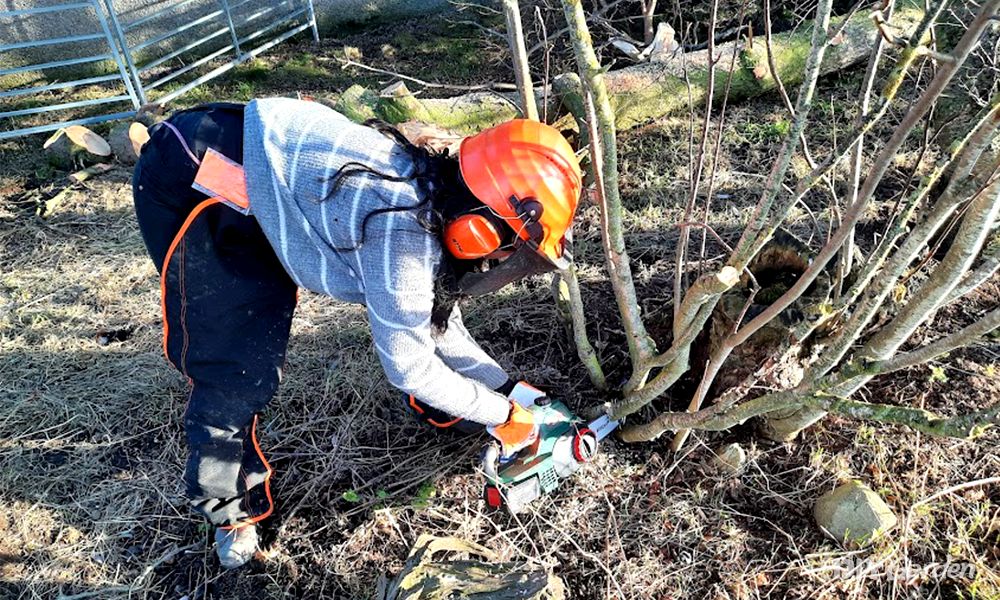
There are a few design elements to this battery powered chainsaw that immediately stand out. Firstly, its size – with a 20cm bar and a very compact body, it’s the smallest of the six cordless chainsaws that I reviewed. Next up, the metal protective cap over the tip of the chainsaw. It’s there to reduce vibration, give you a cleaner cut when pruning trees, and prevent you from cutting with the nose of the chainsaw. Why? Because that requires expertise, whereas this chainsaw is designed for beginners.
While I do understand the point of the tip guard, it did get a little frustrating when using the chainsaw. It would’ve been much better if the guard had been removable. As it was, only about 13cm of the 20cm bar was usable, which really limited the size of branches that I could tackle with this chainsaw. I also noticed that anything larger than 10cm also required a bit of force on my part, which isn’t how a chainsaw should be used.
However, while I wouldn’t really rate this chainsaw for cutting firewood (unless your firewood isn’t too thick), it’s great for pruning small trees. It enabled me to give a tidy haircut to some of the trees around my farm that Storm Arwen had kindly left standing.
The fact that this machine is so small and lightweight (just 3kg, even with the battery in), makes it very easy to manoeuvre and cut in a controlled manner. I used it with a 4aH battery, which enabled me to cut on and off for about two hours. I was impressed with the battery life, but not so much with the machine’s chain speed – at 4.5m/s, it was much slower than some of the other chainsaws that I tested (I would recommend the Makita, at 20m/s, if you’re looking for something faster).
Although this chainsaw is designed for beginners, don’t take safety lightly. While the chainsaw is fitted with a number of important safety features, including recoil protection, a chain brake (in case the chain ever derails), and a button that needs to be held down in order for the trigger to be pulled, I would still highly recommend wearing full chainsaw gear when using this machine. Bosch’s promotional images may make it seem as though it’s safe to use this chainsaw without doing so, but no chainsaw is that safe, including this one.
Bosch products are usually at the higher end of the pricing scale (as I discovered after testing their garden shredders, electric scarifier, cordless leaf blower, and cordless strimmer), but this chainsaw comes in at quite a reasonable cost. That said, its versatility is very limited – for a similar price, you could purchase a larger and more powerful machine instead, although this is unlikely to be as lightweight and as simple to use as the Bosch.
When it comes down to it, this tool is more of a pruning chainsaw, rather than a more general-purpose chainsaw like the others that I tested. If you’re looking for a tool that can slice through large and thick limbs, then this isn’t it. However, if you’re a chainsaw newbie and would like an easy-to-use machine to gain some experience with, then this is the best battery powered chainsaw to go for.
Did you find this review helpful?
5. Einhell GE-LC 18/25 Li Power X-Change Cordless Chainsaw[ SAVE 25% ]
Best for tree pruning and firewood
- Has a 25cm Oregon bar and chain, which is one of the best quality brands for chainsaw parts
- A tool-less design means that no tools are needed for assembly or for tightening the chain
- Cuts smaller branches well
- A lightweight (3.6kg) and comfortable machine to use
- Equipped with a number of important safety features to protect the user from kickbacks and chain malfunctions
- Comes in at a very affordable and reasonable price
- It’s difficult to fit the chain onto the bar, meaning that assembly can take a while and requires you to wear chainsaw gloves
- Struggles to cut larger trunks - 30cm would be the maximum diameter that this machine could handle
- Has quite a slow cutting speed of 4.3 m/s, which means that it can take quite a while to cut through larger pieces of wood
- Uses battery power quickly: a 4.0aH battery has a runtime of just 20 minutes when you’re cutting big pieces of wood. To be fair, this would probably extend to 30-40 minutes if you focused on smaller pieces
- Voltage
- 18V
- Battery
- 1 x 3.0Ah
- Bar Size
- 25cm
- Weight
- 3.6kg
- Assembly Ease
- 3.5
- Design
- 5
- Performance
- 3
- Power
- 4
- Ease of Use
- 5
- Safety
- 5
- Value for Money
- 4.5
Einhell has a reputation for producing power tools and garden machinery at very affordable prices. However, as I found out when I tested their cordless strimmer, electric scarifier, cordless leaf blower, and petrol chainsaw, the brand doesn’t sacrifice on quality either. So, I was expecting their GE-LC 18 Li Cordless Chainsaw to be just as capable. I had a number of trees and branches lying around my farm (thanks to Storm Arwen) that needed to be cut up for firewood, so I was looking forward to putting this chainsaw to the test.
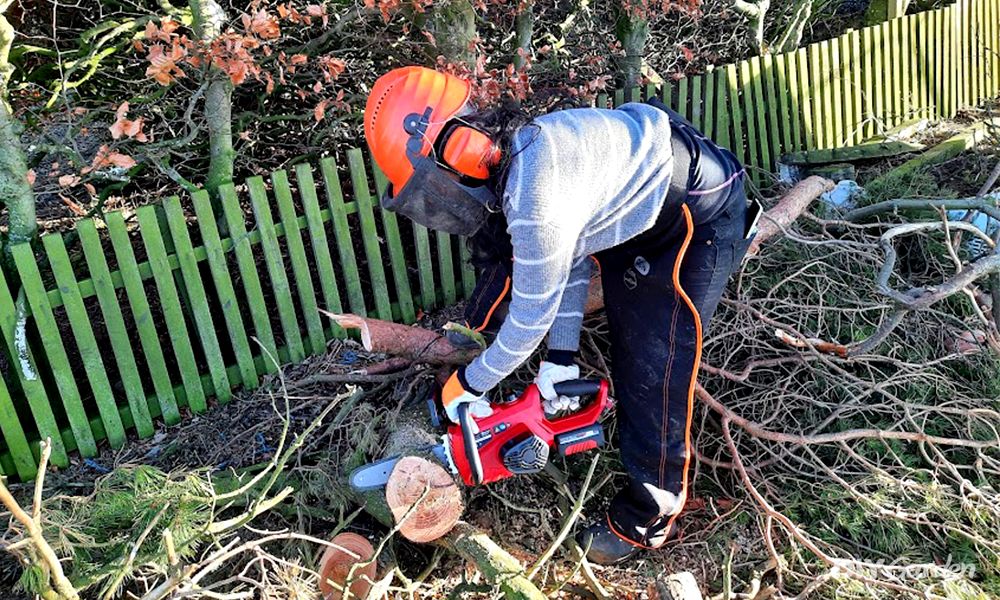
Needless to say, it wasn’t the best start, but things started to look up once I took in the full design of this machine. It has a 25cm Oregon bar and chain, which is a sign of top quality, along with a metal, rather than a plastic, claw stop – again, an indicator of quality. I also appreciated the tool free chain tension adjustment mechanism, as well as the large oil display window.
When it came to performance, this machine both impressed and disappointed me. It was great with smaller branches but not so great with larger tree trunks, to the point where the motor cut out a few times because I kept getting frustrated and unintentionally put too much pressure on it. It also has quite a slow cutting speed of just 4.3 m/s. Again, this isn’t really noticeable when you’re cutting smaller pieces of wood, but it makes things more tedious when you’re working with larger limbs.
I used a 4.0aH lithium ion battery with this chainsaw, and it gave me a cutting time of about 20 minutes. This is a pretty short runtime, but then again, I was cutting very thick wood – if you’re using it for small pieces, you won’t put as much pressure on the motor, and will therefore enjoy a longer runtime. The good thing about Einhell Power X-Change batteries is that they charge quickly – it only took about an hour for my 4.0aH battery to go from empty to full.
In terms of how easy this chainsaw is to use, I would give it top marks. It’s pretty compact and, at 3.6kg, lightweight enough to not leave you with sore arms. It also has an automatic oiling system that keeps the chain consistently greased up with oil, although I’ve yet to see a chainsaw that doesn’t offer this feature.
I was pleased to see that Einhell incorporated a number of safety features into this chainsaw. From its kickback protection to its emergency chain brake to its chain stop bolt – these are all in place to protect you if the chainsaw ever malfunctions. Of course, while that may be the case, accidents still happen, so make sure that you’re wearing all of the right protective clothing and accessories!
While I may have found a few more flaws to this battery powered chainsaw when compared to the others that I tested, its price makes up for these. This is a very affordable machine – you’d struggle to find a good chainsaw for any cheaper, especially one that doesn’t skimp out on quality.
With that in mind, this is a great machine for anyone that needs a chainsaw for lighter work around the home and garden. While it wouldn’t be a good fit for someone looking for powerful, heavy-duty capabilities, it’s the best batter powered chainsaw for tree pruning and cutting firewood as well as cutting wood for DIY and construction tasks. It’s surprisingly versatile and, even better, it’s a bargain for what it costs!
Did you find this review helpful?
6. WESCO 36V Cordless Chainsaw
Best for no assembly
- No assembly required - this chainsaw comes fully assembled in the box
- Has a 36V motor that takes two 18V batteries, making it more powerful than the cordless chainsaws that take just one 18V battery
- Two 5aH batteries run the chainsaw for a continuous stretch of 45 minutes
- Comes with a 30cm cutting bar that allows it to slice through wood that’s roughly 50cm in diameter
- The chain can be easily tightened without the need for any tools
- Fitted with a number of safety features designed to protect the user from kickbacks and chain breakages
- At 7.16kg, some may find this chainsaw to be a little too heavy
- Has a 6m/s cutting speed, which is still very adequate, but could have been better considering the machine’s high power
- Voltage
- Twin 18V (36V)
- Battery
- 2 x 4.0Ah
- Bar Size
- 30cm
- Weight
- 7.16kg
- Assembly Ease
- 5
- Design
- 5
- Performance
- 5
- Power
- 4
- Ease of Use
- 4
- Safety
- 5
- Value for Money
- 5
Even those who have never heard of WESCO before would take a second look at the WESCO 36V Cordless Chainsaw. At first glance, it certainly appears impressive, so I had high hopes for its ability to help me tidy up the branches that Storm Arwen had scattered around my farm.
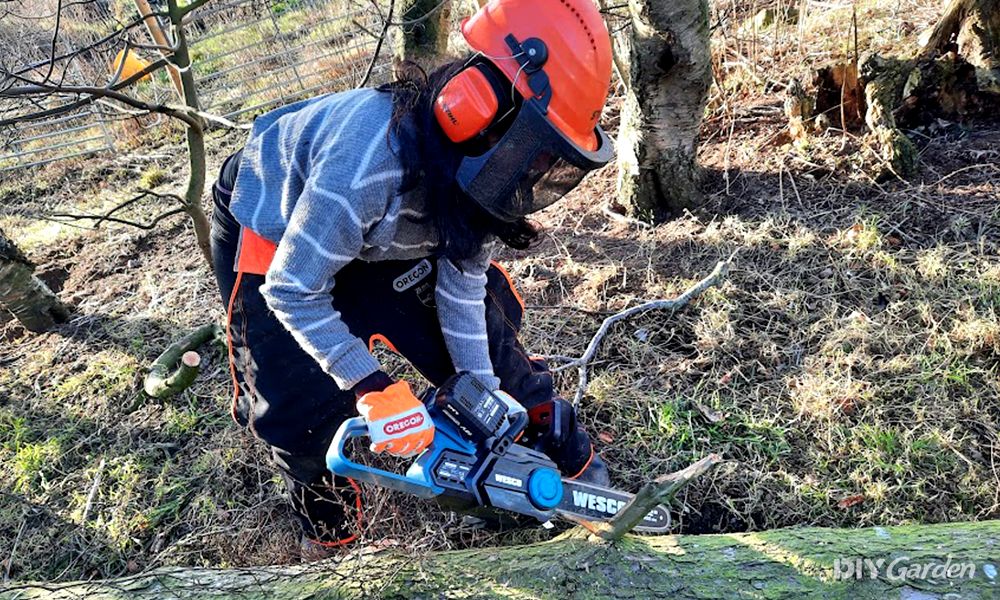
That’s right, I said batteries – plural. This 36V battery powered chainsaw has been designed to run on two 18V batteries. This gives it a chunkier look and feel than those that hold just one battery. It boasts a few other thoughtful design features too, from its claw stop to its oil level indicator to its handy on/off button. Its cutting bar is 30cm in length, which is on the higher end of the scale for cordless chainsaws.
I was very happy with how this machine performed. It neatly sliced through both large branches and small trunks, with the maximum diameter it could handle being roughly 50cm (when you cut from both sides).
It definitely feels a lot more powerful than many of the other cordless chainsaws that I tested. The only one that beat it was the 36V Makita, and this was mainly because its cutting speed was faster than the 6m/s that the WESCO offers. However, with the slower cutting speed comes longer battery life – two 5aH batteries gave me a continuous run time of about 45 minutes when used on thick wood.
I found this chainsaw to be very easy to use. The only potential downside would be its weight. 7kg is pretty heavy for a cordless chainsaw, but considering that you’re only going to be using it for a maximum of 45 minutes at a time (before the battery power runs out), its weight isn’t a dealbreaker in the slightest. In fact, I found that this actually gave the machine a sturdiness that made it easier to hold in place when cutting.
There are several safety features incorporated into this machine, including a low kickback feature and a quick stop chain brake. You also need to push in a button before pulling the trigger to turn the machine on, saving anyone from doing so accidentally. That said, as safe as I felt using this battery powered chainsaw, make sure that you’re always wearing the right protective gear.
There are both pros and cons to this chainsaw’s price. While you could bag yourself a more powerful petrol chainsaw for almost half the price, this one offers up a number of features that are worth paying more for. For many, the most important would be how it’s pretty much ready to get going as soon as it’s out of the box – the ultimate in chainsaw convenience! Compared to other cordless chainsaws, its price is reasonable, especially considering that it comes with two batteries (plus a dual charger) and a two year manufacturer’s warranty.
All in all, I was pleasantly surprised by this chainsaw. Since I had never heard of WESCO before, I wasn’t expecting much, but this machine proved me wrong. It’s not a chainsaw that I would turn to if I was planning on spending all day felling mature trees, but it’s the best battery powered chainsaw if for the average home user who needs a tool that’ll help them cut firewood, as well as the occasional small tree. Plus, there’s no assembly required.
Did you find this review helpful?
Product Tester
To get to the bottom of the best cordless chainsaw, I tested a variety of chainsaws, both from the most renowned and lesser-known manufacturers. I assessed each chainsaw on its assembly ease, design, performance, power, ease of use, safety, and value for money. Here is how I tested:
- Assembly Ease: I assessed assembly ease on how long it took to put the chainsaw together and the clarity of the instructions provided. I deemed any chainsaws that took more than 20 minutes too long, as this may take significantly longer for someone who is unfamiliar with this tool. I also marked down chainsaws that didn’t provide clear instructions, those that took longer than specified, or models where the parts didn’t seamlessly fit together. Chainsaws that required no assembly were given top marks, as these designs made the tool more accessible for less experienced users.
- Design: A well-designed cordless chainsaw will have considered ergonomics, with a comfortable handle and grip. Models with cushioned or anti-vibration handles were given top marks as these made the chainsaws more comfortable to use for long periods. I also looked for chainsaws with balanced weight distributions, as this improves the user’s manoeuvrability and control. While the optimal bar length varies depending on the tasks, those with longer bars (of 25 cm +) could complete a wider range of tasks, so they were given higher marks. I also identified whether each chainsaw’s bar length matched up with its power – for example, an 18 V system for a 15 – 20 cm bar chainsaw or a 36 V system for chainsaws with 30 cm bars and above.
- Performance: As these were all cordless models, I timed how long each model ran before having to be charged. Models with long run times of 25 minutes and over were given the best marks as these were suitable for all tasks within the garden. Chainsaws that provided spare batteries were also given better ratings as this significantly extended the usable time. I also looked for chainsaws with a fast cutting speed of between 10 m/s and 20 m/s, as these were the most efficient models.
- Power: Chainsaws weighing under 5 kg were given the best ratings as these tended to be powerful and easy to manoeuvre and control. Those that were particularly light (around 3 kg) but still offered a good amount of power were also scored highly.
- Ease of Use: Cordless chainsaws with well-designed, clearly labelled controls and switches were given better ratings as these make it easier for users to operate the chainsaw effectively. Lightweight designs and those with tool-less chain tensioning were also given higher marks as these made use far easier for the average user. I also considered features such as clear oil level indicators, vibration, and how easy it was to attach and detach the battery.
- Safety: Chainsaws with an adequate combination of safety features, such as a chain brake and kickback brake, were given good marks. Those that had an automatic chain-oiling system and a protective cap on the tip of the chainsaw were given top marks, as these were particularly safe for beginner users. Features like throttle locks, safety interlocking systems, hand guards, and chain catchers were also scored highly.
- Value for Money: I compared each model’s design, performance, power, safety and ease of assembly and use against its price point. Chainsaws that offered a lot of features, excellent performance, and easy usage while remaining affordable were deemed the best value for money.
Compare Product Features
Use the dropdown to sort the table by the feature you want to see.
Ryobi RCS1830-150 18V ONE+ Cordless Brushless Chainsaw
- 4.8
- 18V
- 1 x 5.0Ah
- 30cm
- 2.5kg
Makita DUC353Z Twin Li-Ion LXT Cordless Chainsaw
- 5
- Twin 18V (36V)
- Not Included
- 35cm
- 4.04kg
WORX WG322E.9 18V Cordless Compact Chainsaw
- 4.1
- 20V
- 1 x 2Ah
- 25cm
- 3.1kg
Bosch Cordless Chainsaw UniversalChain 18
- 4.2
- 18v
- 1 x 4.0Ah
- 20cm
- 3.2kg
Einhell GE-LC 18/25 Li Power X-Change Cordless Chainsaw
- 4.3
- 18V
- 1 x 3.0Ah
- 25cm
- 3.6kg
WESCO 36V Cordless Chainsaw
- 4.7
- Twin 18V (36V)
- 2 x 4.0Ah
- 30cm
- 7.16kg
How to Choose the Best Cordless Chainsaw
Back in the day, battery chainsaws used to be weak and ineffective. If you wanted a chainsaw that could get the job done well, then your only real option was to go with a petrol-powered machine.
Thankfully, this is no longer the case. The cordless chainsaws of today are now more powerful and efficient than ever. In some cases, their performance even rivals that of the best petrol chainsaws.
However, with so many different battery-powered chainsaw models out there, which one do you pick? Stick with us as we share all of the points that you’ll need to consider when choosing a new cordless chainsaw.
The Benefits of a Cordless Chainsaw
Still on the fence about whether to go with a cordless chainsaw over a petrol or electric model? Here are just a few of the benefits that a cordless chainsaw can offer:
- They’re very lightweight when compared to petrol chainsaws – this not only makes them easier to move around to different parts of your garden, but also gives you more manoeuvrability if you need to take your chainsaw up a ladder or a tree
- Convenience – you don’t need to worry about mixing up petrol, or about electric cables getting in the way, when you use a cordless chainsaw
- Easy to start – as soon as you hit the on/off button and pull the trigger, a cordless chainsaw kicks into action. Unlike a petrol chainsaw, you don’t need to worry about priming, choking, or pull-starting
- Less noise – one of the biggest advantages of a battery-powered chainsaw is that it’s far quieter than its petrol alternatives. There’s usually less vibration too, making it more comfortable to operate
- Health benefits – in addition to saving yourself from the noise that a petrol chainsaw makes, a cordless chainsaw also won’t subject you to exhaust fumes
The Importance of Battery Runtime
As we found when we reviewed six of the top cordless chainsaw models available, battery runtime greatly varies between models, even if you’re using the same sized battery. The difference can be pretty significant – a 5aH battery could give you 15 minutes of runtime with one model, yet 45 minutes with another.
Why such a discrepancy? Because everything from motor power to cutting speed to the wood that you’re working with affects runtime. This isn’t something that you’ll be able to easily test yourself before purchasing a chainsaw, but we would recommend reading through the many reviews out there to give yourself an idea of what the potential runtime would be for the model you’re considering.
It’s worth mentioning that some cordless chainsaws run on two batteries, rather than just one. However, don’t assume that this automatically correlates to a longer runtime – it could just be that two batteries are needed to run a powerful motor, and you may still end up with a shorter runtime than a chainsaw that uses just one battery.
Cutting Bar Length
The length of a chainsaw’s cutting bar will determine the size of wood that you can use the machine on. Although cordless chainsaws usually have a shorter bar than petrol chainsaws, there’s still a fair bit of variation to choose from, usually between 15-30cm.
If you’re only going to be cutting small and thin pieces of wood, then a short bar is all you need. However, if you plan on using your chainsaw to cut chunky logs and to fell trees, then go with a longer bar.
Understanding Motors
Cordless chainsaw motors come in different sizes. It goes without saying that the larger the motor, the more powerful your chainsaw will be. The downside to a large motor is that this will detract from your battery’s runtime.
It’s also worth checking whether or not the chainsaws you’re considering have brushless motors. These are becoming increasingly common and help to make a battery-powered chainsaw much more efficient.
Cutting Speed
A chainsaw’s cutting speed will tell you how fast that machine will be able to saw itself through a piece of wood. Smaller models could have a cutting speed of just 4 m/s, whereas higher-end cordless chainsaws can offer up to 20 m/s, which is comparable to a petrol chainsaw.
If you plan on only occasionally cutting smaller pieces of wood, then a slower cutting speed won’t make much of a difference. However, if you’re going to be using your chainsaw regularly on large chunks of timber, then a faster cutting speed will save you so much time.
Checking for Safety Features
Although they may be smaller and lighter than their petrol alternatives, cordless chainsaws still have the potential to cause just as much damage should an accident occur. As a result, you need to take safety very seriously.
First and foremost, even if you don’t plan on using your cordless chainsaw for heavy-duty tasks, you’ll still need to invest in protective clothing and accessories, including chainsaw trousers, boots, gloves, and a hat/helmet, as well as safety goggles and ear defenders (these usually come attached to the helmet). This is something required by law, so don’t take it lightly.
It’s also vital that the chainsaw you’re buying is fitted with appropriate safety features. Ideally, look for a model that offers both a chain brake, as well as a kickback brake. A hand guard is important too but pretty much every chainsaw will come with this.
Comfort and Ease of Use
If you’re going to be investing in a cordless chainsaw, then you’ll want a machine that’s going to be comfortable and easy to use. For this, you’ll need ergonomic, soft-grip handles, which most chainsaws usually come with. A secondary handle is also useful for giving you extra manoeuvrability.
Don’t forget to also check how much your chosen chainsaw weighs with the battery in. While it’s true that a lighter chainsaw is easier to move around, a little bit of weight is also helpful when it comes to keeping the chainsaw sturdy and steady while it’s in use. Most cordless chainsaws weigh somewhere between 5-7kg.
Cordless Chainsaw FAQs
There are pros and cons to both. A cordless chainsaw is usually lighter and easier to use, whereas petrol chainsaws tend to offer more power and a faster cutting speed. That said, there are always exceptions – many cordless chainsaws are now just as good as petrol models, so it all depends on the one you choose.
Cordless chainsaws are much quieter than petrol alternatives. However, the use of ear protection is still recommended.
So long as you use a chainsaw with a cutting bar that’s appropriate to the size of tree in question, then yes, a cordless chainsaw is more than capable of felling a tree.
In the UK, you don’t need a licence to operate a battery-powered chainsaw. However, by law, you’re required to wear all of the necessary protective gear, as well as undergo chainsaw training.
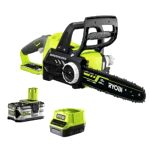
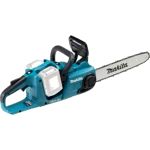
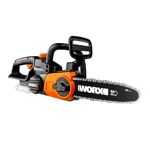
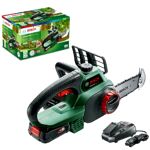

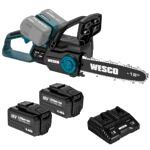
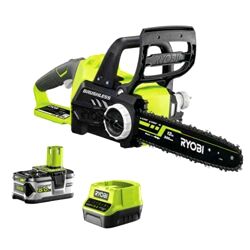
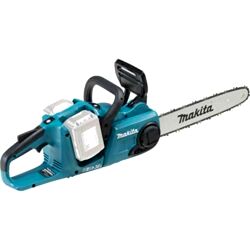
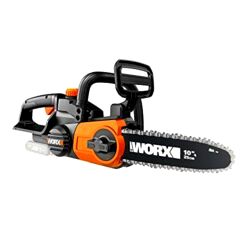
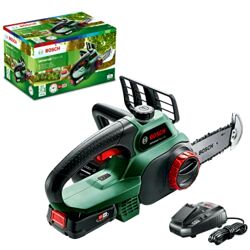
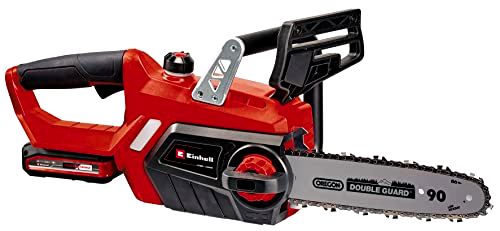
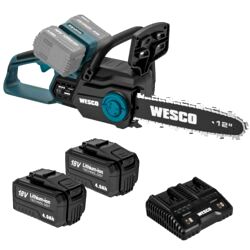
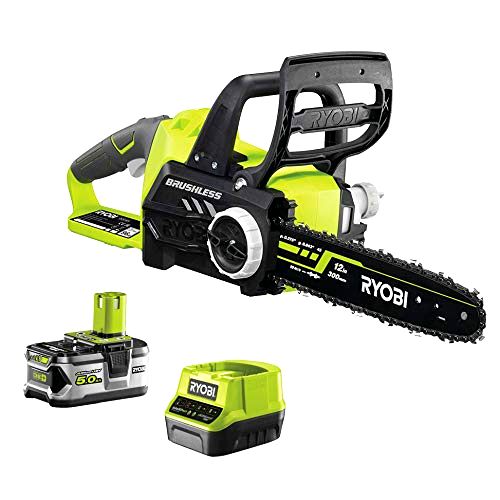
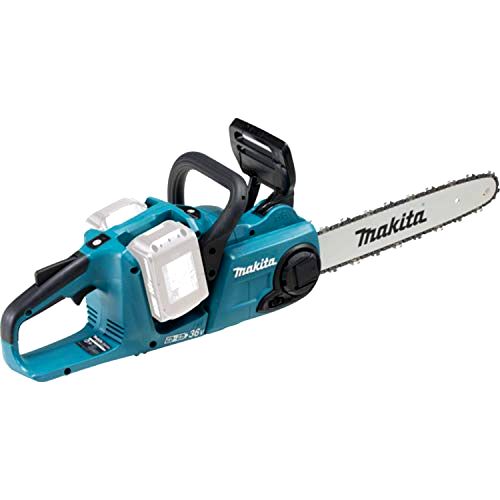
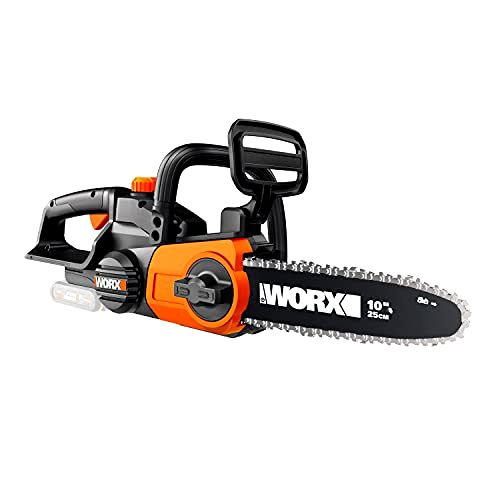
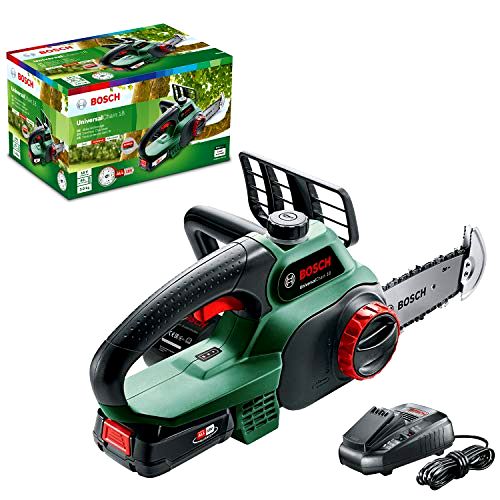
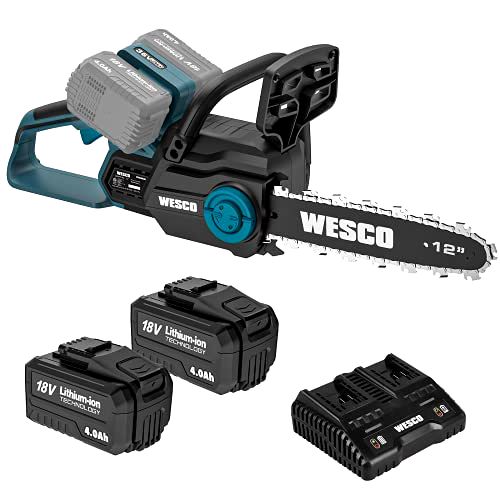

Share